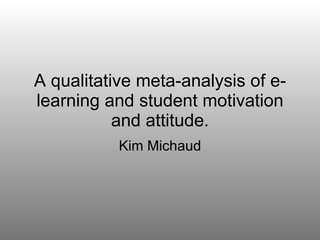
C:\Documents And Settings\Kim\Desktop\6610michaudmodule3b
- 1. A qualitative meta-analysis of e-learning and student motivation and attitude. Kim Michaud
- 6. Findings of the studies: purpose, methods, frameworks
- 44. REFERENCES 1- DeVaney, T.A. (2009). Impact of video tutorials in an online educational statistics course. MERLOT Journal of Online Learning and Teaching, 5 (4), 600-608. 2- Kim, C., & Keller, J.M. (2008). Effects of motivational and volitional email messages (MVEM) with personal messages on undergraduate students’ motivation, study habits and achievement. British Journal of Educational Technology, 39(1), 36-51. 3- Bugos, J.A., Dixon, M.B., & Nelson, J. (2009) Podcasting: A method of enhancing course perceptions and performance in music appreciation international. International Journal of Instructional Technology and Distance Learning, 6(1). 4- Hodge, A., Richardson, J. C., & York, C. S. (2009). The impact of a web-based homework tool in university algebra courses on student learning and strategies. MERLOT Journal of Online Learning and Teaching, 5(4), 618-629. 5- George-Palilonis, J., & Filak, V. (2009). Blended learning in the visual communications classroom: Student reflections on a multimedia course. Electronic Journal of e-Learning, 7(3), 247 – 256. 6- Bradshaw, A.C., & Johari, A. (2008). Project-based learning in an internship program: A qualitative study of related roles and their motivational attributes. Educational Technology Research and Development, 56 (3), 329-359. 7- Reeves, T.C., & Wang, S. (2006). The effects of a web-based learning environment on student motivation in a high school earth science course. Educational Technology Research and Development, 54(6), 597-621.
- 45. 8- Lee, T., Shen, P., Ting, C., & Tsai, C. (2008). Exploring the effects of web-enabled problem-based learning and self-regulated learning on vocational students’ involvement in learning. European Journal of Open, Distance, and E-Learning, 1(9). 9- Liu, M. (2006). The effect of a hypermedia learning environment on middle school students' motivation, attitude, and science knowledge. Computers in the Schools , 22(3), 159 -171. 10- Murphy, E., & Rodriguez-Manzanares, M.A. (2009). Teachers’ perspectives on motivation in high school distance Education. Journal of Distance Education, 23(3), 1-24. 11- Bassili, J.N. (2008). Motivation and cognitive strategies in the choice to attend lectures or watch them online. Journal of Distance Education, 22(3), 129-148. 12- Kikuchi, H. (2006). Motivational factors affecting online learning by Japanese MBA students. Australasian Journal of Educational Technology, 22(3), 398-415. 13- Tirotta, R., & Torff, B. (2010). Interactive whiteboards produce small gains in elementary students’ self-reported motivation in mathematics. Computers & Education 54(2), 379-383. 14- Zhang, T., Koehler, M.J., & Spatariu, A. (2009). The development of the motivation for critical reasoning in online discussions inventory. American Journal of Distance Education , 23(4), 194-211.
- 46. 15- Choi, H. J., & Johnson, S.D. (2005). The effect of context-based video instruction on learning and motivation in online courses. American Journal of Distance Education, 19(4), 215-227. Ames, C. A. (1990). Motivation: What teachers need to know. Teacher College Record , 91(3), 409-421.
Notas do Editor
- I moved this here- next slide- just have inclusion criteria then inclusion criteria
- Get rid of same material I suggested you get rid of on last slide. Get rid of metaanalysis of e-learning’s impact on student motivation and attitude began with a journal and article search using… Start with inclusion criteria For spoken part: Not a journal and article search –instead identification of 15 studies with the following inclusion criteria.
- Drag all maps so they fill full screen. Avoid repetition –maybe just have only two slides with inclusion ctiera and exclusion criteria.
- What was the question?
- I don’t understand what this slide is about.
- Careful of spelling mistakes.
- Take out methods included –start with theoretical frameworks
- Instead use a table from your paper and insert it. Methods of papers did not include journals, surveys interview questionnaires.. YOU can’t say that student perceptions were using qualitative research etc. This slide needs to be completely revised-I suggest a table.
- table
- Not sure this is all clear. E.g., I’m nost sure I understand factors affecting student motivation such as finishing requirements.
- You can make numbers smaller. You don’t need boxes around linking words.
- Rather than always repeating studies found, why not have an opening slide with just the words synthesis on findings on it. It’s confusing to have boxes around concepts and linking words- get rid of boxes around linking words.
- Don’t highlight just one study and use a standard referencing format. Don’t understand 3 categories being ….
- Use same format for findings and methods sections
- Start with technology….
- Start with technology…
- Use same format for findings and methods sections
- Revise to get rid of studies propose…
- ditto
- Use same format for findings and methods sections
- Hard to tell what are concepts and what are linking words. Get rid of commonalities in research
- ditto
- Rather than have three slides on this topic-can you combine?
- Use same format for findings and methods sections
- Don’t use punctuations e.g. ; fix arrows where necessary
- Use same format for findings and methods sections
- Start with Need to improve
- Research can
- diito
- Use same format for findings and methods sections
- Get rid of within the meta… Don’t know what you mean spread across elemnt…
- Don’t centre